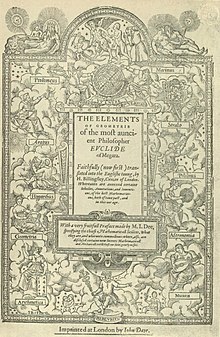
Back Euklids Elemente ALS الأصول (كتاب) Arabic عناصر اوكليديس ARZ Elementos d'Euclides AST Başlanğıclar (Evklid) Azerbaijani Пачаткі Эўкліда Byelorussian Елементи Bulgarian মৌলিক উপাদানসমূহ (ইউক্লিড) Bengali/Bangla Elements d'Euclides Catalan توخمەکانی ئیقلیدس CKB
 Title page of Sir Henry Billingsley's first English version of Euclid's Elements, 1570. During the Renaissance, Euclid was commonly conflated with the philosopher Euclid of Megara. | |
| Author | Euclid |
|---|---|
| Language | Ancient Greek |
| Subject | plane and solid geometry, number theory, incommensurable lines |
| Genre | Mathematics |
Publication date | c. 300 BC |
| Pages | 13 books |
The Elements (‹See Tfd›Greek: Στοιχεῖα Stoikheîa) is a mathematical treatise consisting of 13 books attributed to the ancient Greek mathematician Euclid c. 300 BC. It is a collection of definitions, postulates, propositions (theorems and constructions), and mathematical proofs of the propositions. The books cover plane and solid Euclidean geometry, elementary number theory, and incommensurable lines. Elements is the oldest extant large-scale deductive treatment of mathematics. It has proven instrumental in the development of logic and modern science, and its logical rigor was not surpassed until the 19th century.
Euclid's Elements has been referred to as the most successful[a][b] and influential[c] textbook ever written. It was one of the very earliest mathematical works to be printed after the invention of the printing press and has been estimated to be second only to the Bible in the number of editions published since the first printing in 1482,[1] the number reaching well over one thousand.[d] For centuries, when the quadrivium was included in the curriculum of all university students, knowledge of at least part of Euclid's Elements was required of all students. Not until the 20th century, by which time its content was universally taught through other school textbooks, did it cease to be considered something all educated people had read.[citation needed]
Cite error: There are <ref group=lower-alpha> tags or {{efn}} templates on this page, but the references will not show without a {{reflist|group=lower-alpha}} template or {{notelist}} template (see the help page).
- ^ Boyer 1991, p. 100.